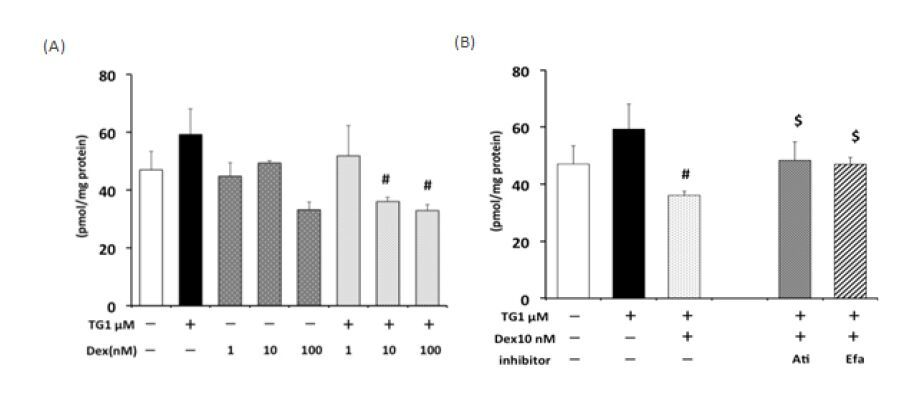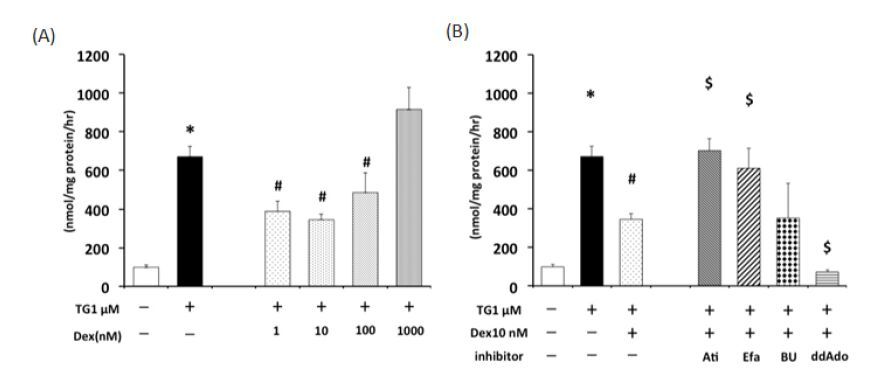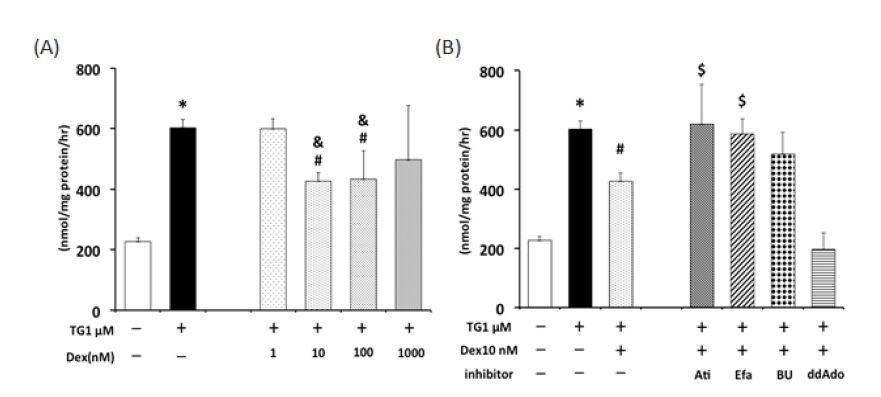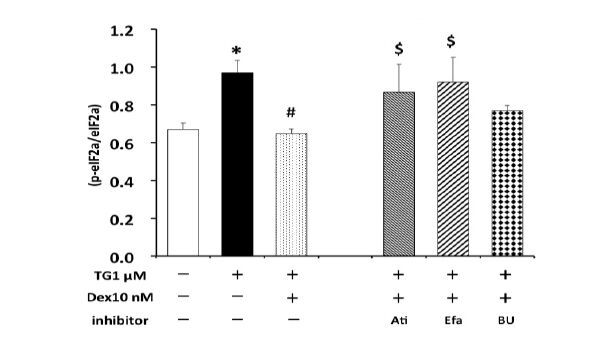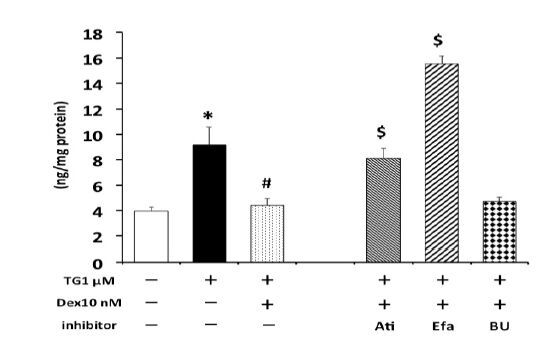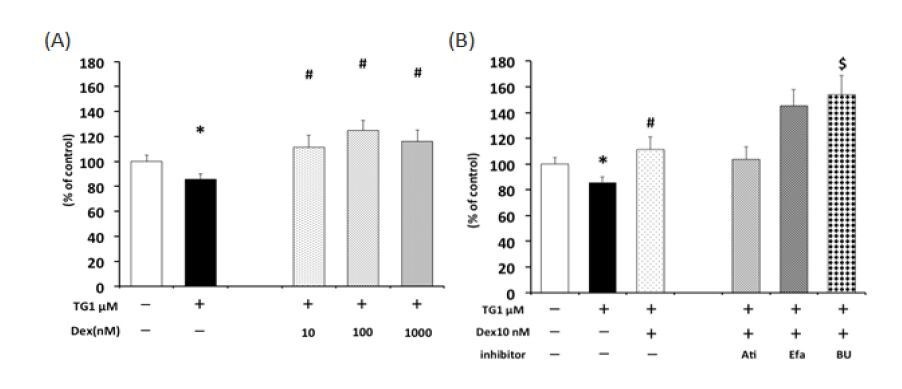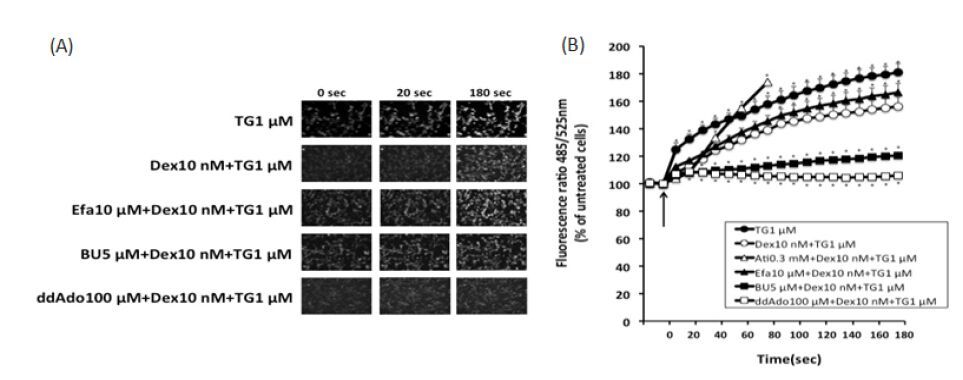1. Introduction
Dexmedetomidine (Dex) is a selective α2-adrenoceptor agonist widely used to sedate patients under artificial respiration in an intensive care unit, though analgesic effects of the drug have also been observed [1,2,3,4,5]. In addition, research has revealed that Dex exerts neuroprotective effects in nerve tissue under ischemic conditions [6,7,8,9] and exhibits affinity for imidazoline receptors (I1-, I2-receptors) at its imidazole group [10,11,12,13]. However, the precise mechanisms underlying these neuroprotective effects remain to be elucidated.
Ischemic and hypoxic conditions often result in widespread cellular damage, including impairment of ER functions [14]. Following transient cerebral ischemia, the ER of nerve cells become swollen and dilated, and polyribosomes disaggregate from the surface of the ER membrane [15]. Such changes are thought to reflect the inhibition of protein synthesis via protein kinase R-like ER kinase (PERK) activation and the arrest of vesicular transport/secretion from the ER due to the unfolded protein response (UPR). Although it is difficult to determine to what extent ER-stress is associated with cellular injuries in the central nervous system following ischemic hypoxia, intracellular morphological abnormalities have been observed in mitochondria as well. Many cases of central neurodegeneration [16] and decreased levels of lymphocytes [17] have been reported following general anesthesia with volatile agents. Such cellular damage may be associated with Ca2+ release from the ER.
SH-SY5Y cells are derived from the thrice-cloned human neuroblastoma cell line (SK-N-SH) and have been widely utilized in studies of various neurodegenerative disorders, including Parkinson’s disease, Alzheimer's disease, and traumatic brain injury. Furthermore, research has revealed that long-term exposure to thapsigargin (TG), which is known to induce ER-stress, may induce apoptosis in SH-SY5Y cells [18]. Clarifying the mechanisms underlying the inhibitory effects of Dex on ER-stress is critically important in assessing the clinically applicability of such treatment. Therefore, in the present study, we investigated whether Dex exerts neuroprotective effects and inhibits apoptosis due to ER-stress induced by TG exposure in SH-SY5Y cells, and whether such effects are associated with α2-adrenoceptors or I1-, I2- receptors in these cells.
2. Materials and Methods
2.1. Drugs and reagents
Dexmedetomidine (Dex), thapsigargin (TG), and Dulbecco’s modified Eagle’s medium (DMEM Ham’s F-12) were purchased from Wako Co. (Osaka, Japan). Fetal bovine serum (FBS), atipamezole, efaroxan, BU99006, and 2’, 5’-dideoxyadenosine (ddAdo) were purchased from Sigma-Aldrich Co. (MO, USA). Penicillin G sodium, streptomycin sulfate, and amphotericin B were obtained from Life Technologies (CA, USA). All other chemicals used in this experiment were obtained at the purest commercially available grade.
2.2. Cell culture and drug treatment
SH-SY5Y cells (human neuroblastoma, EC-94030304) were obtained from the European Collection of Cell Cultures (ECACC, London, UK) and cultured in DMEM Ham’s F-12 containing 10% FBS and Penicillin G sodium, streptomycin sulfate, and amphotericin B. Cells were maintained in a humidified atmosphere of 5 % CO2 and 95 % air at 37˚C. In order to assess the effect of TG, SH-SY5Y cells were incubated in DMEM Ham’s F-12 with or without TG (used as a control) for 20 hours. We previously reported that ER-stress was induced by TG (1 μM) treatment in SH-SY5Y cells [19]; therefore, we utilized this concentration in the present study. In order to investigate the effects of Dex treatment, SH-SY5Y cells were pretreated with various concentrations of Dex (1-1000 nM) for 1 hour before co-treatment with TG (1 μM) for 20 hours. We incubated SH-SY5Y cells with or without pretreatment agents along with their respective inhibitors for 10 minutes as follows: 0.3 μM atipamezole (α2-adrenoceptor antagonist), 10 μM efaroxan (α2- and I1-receptor antagonist), 5 μM BU99006 (I2-receptor ligand), or ddAdo (adenylyl cyclase inhibitor). Cells were then treated with TG +Dex10 nM for 20 hours (Figure 1). All treatments were performed under sterile conditions.
2.3. Assay of cyclic AMP (cAMP) level
We used the Cyclic AMP ELISA kit (Cayman chemical company, MI, USA) to assess the concentration of Camp in SH-SY5Y cells pretreated with various concentrations of Dex (1-1000 nM). Both pretreated and non-pretreated SH-SY5Y cells were incubated with their respective α2-adrenoceptor or I1-, I2-receptor inhibitors for 10 minutes, followed which they were treated with TG +Dex 10 nM for 20 hours. Atipamezole is a selective antagonist of α2-adrenoceptors, with an affinity for α2-adrenoceptors 8000 times greater than that for α1-adrenoreceptors. Zhang et al. reported that Dex (50nM) is significantly antagonized by atipamezole (300 nM) [20]. Therefore, we utilized this level of atipamezole (300 nM) in the present study. Efaroxan, on the other hand is an antagonist for both α2- and I1-receptors, and we employed concentrations of 10 µM based on a previous report by Zhang et al [21]. Levels of cyclic AMP were then assessed in accordance with manufacturer’s protocol.
2.4. Measurement of caspase-3 and -4 activity
Following incubation, the cells were rinsed with cold PBS, re-suspended in chilled cell lysis buffer (Cell Signaling Technology Inc., MA, USA), and incubated for 10 minutes on ice. The lysates were then added to a reaction buffer containing 10 mM DTT (Medical & Biological Laboratories Co. Ltd., Aichi, Japan) and the respective specific peptide substrates and then incubated at 37˚C for 2 hours. Substrates for caspase-3 and caspase-4 were Asp-Glu-Val-Asp-7-amino-4-trifluoromethy coumarin (DEVD-AFC) (Kamiya Biochemical Company, Seattle, WA, USA) and Leu-Glu-Val-Asp-AFC (LEVD-AFC) (Bio Vision Technology Inc., SF, USA), respectively. AFC released via enzymatic reactions was measured spectrophotometrically at an excitation wavelength of 405 nm and an emission wavelength of 505 nm using the Spectra Max i3 (Molecular Devices Co., CA, USA). Supernatants were collected, and protein content was determined by Bio-Rad Protein Assay using bovine serum albumin (BSA) as a standard.
2.5. Assay of eIF2α (eukaryotic translation-initiation factor 2α) phosphorylation
We used the eIF2α ELISA kit (Cell Signaling Technology, Inc., MA, USA) to examine the phosphorylation of eIF2α. Following the 20-hour TG +Dex10 nM treatment, cells were fixed and blocked according to manufacturer protocol and subsequently incubated with either anti-phospho-eIF2α (Thr183/Tyr185) or anti-eIF2α (primary antibody), after which they were examined spectrophotometrically at 405 nm with the Spectra Max i3 (Molecular Devices Co., CA, USA).
2.6. Assay of C/EBP homologous protein (CHOP)
For quantitative determination of CHOP in SH-SY5Y cell lysates, we used the ELISA kit for DNA damage inducible transcript3 (CHOP) (Uscn Life Science Inc. Wuhan, China). Cells were fixed and blocked as directed in the manual, following which they were examined spectrophotometrically at 450 nm with the Spectra Max i3 (Molecular Devices Co., CA, USA). CHOP levels were then assessed using the Mît-E-ψ™ mitochondrial permeability detection kit (Enzo Life Sciences, Inc., NY, USA).
2.7. Change in mitochondrial membrane potential
A collapse in the mitochondrial membrane potential Δψ is one of the earliest indications of apoptosis. We detected changes in mitochondrial Δψ in hepatocytes using fluorescent the mitochondrial probe JC-1 (5, 5', 6, 6’-tetrachloro-1, 1’, 3, 3’-tetraethyl- benzimidazolcarbocyanine iodide) [22]. In hepatocytes not undergoing apoptosis, the mitochondrial Δψ remains intact, and the JC-1 fluorescence reagent accumulates and aggregates in the mitochondria, fluorescing red. At relatively low concentrations, JC-1 exists in a monomeric form that fluoresces at 527 nm, but when concentrated in the mitochondria and undergoing active respiration, JC-1 aggregates in a form that fluoresces at 590 nm. The intensity of fluorescence at 590 nm is proportional to the mitochondrial Δψ, which may be used to indicate the closure of permeability transition pores. When mitochondrial membrane permeability transition (MMPT) is induced, Δψ is dissipated and the formation of JC-1 aggregates is prevented, resulting in diminished fluorescence at 590 nm. SH-SY5Y cells were treated with TG or TG +Dex10 nM for 20 hours and then loaded with JC-1 for 15 minutes at 37˚C in a CO2 incubator. After washing the hepatocytes, changes in mitochondrial Δψ were assessed by comparing the ratio of 590 nm (red)/527 nm (green) emissions with the Spectra Max i3 (Molecular Devices Co., CA, USA).
2.8. Intracellular free Ca2+ ([Ca2+]i) measurements
Levels of [Ca2+]i were analyzed using a FLIPR Calcium 5 Assay Kit (Molecular Devices, Inc., CA, USA). SH-SY5Y cells were loaded with FLIPR reagent diluted in Hank’s balanced salt solution + 20 mM Hepes buffer (pH 7.4) for 1 hour at 37˚C. Changes in the [Ca2+]i were then measured by monitoring the FLIPR fluorescence signals with an excitation wavelength of 485 nm and emission wavelength of 525 nm with the Meta Xpress Image Acquisition and Analysis software (Molecular Devices Inc., CA, USA).
2.9. Statistical analysis
Each measurement was repeated three times. Results are expressed as mean ± standard error of the mean (S.E.M). One-way analyses of variance (ANOVA) were used to compare the effects of various treatments with those of untreated cells. Post hoc testing was performed using Dunnett’s test. Differences with p-values less than 0.05 were considered statistically significant.
3. Results
3.1. Dexmedetomidine decreased intracellular cAMP
Dex binds to the Gi-coupled α2-adrenoceptor, inhibiting adenylyl cyclase activity and downregulating cAMP formation [23]. We investigated whether cAMP is involved in the cytoprotective effects exerted by Dex. Pretreatment with Dex (10, 100 nM) significantly decreased cAMP levels in SH-SY5Y cells exposed to TG-induced ER-stress (Figure 2-A). When cells were incubated with atipamezole or efaroxan prior to co-treatment with Dex (10 nM) and TG (1 μM), cAMP levels significantly increased when compared to TG+Dex 10 treatment alone (Figure 2-B).
3.2. Dexmedetomidine reduced caspase-3 activity in ER-mediated apoptotic cells
Apoptosis mediated by TG-induced ER-stress was detected via assessment of caspase-3 activity (Figure 3). After incubation with TG (1 μM) for 20 hours, caspase-3 activity significantly increased compared with that of untreated control cells. Figure 3-A depicts levels of caspase-3 activity in SH-SY5Y cells treated with or without TG (1 μM) in the presence or absence of pretreatment with Dex (1-1000 nM) for 20 hours. Caspase activity was determined using synthetic fluorometric substrates as described in the Materials and Methods section. Caspase-3 activity significantly increased following TG (1 μM) treatment, and this increase was significantly suppressed following pretreatment with Dex (1, 10, and 100 nM). However, pretreatment with Dex at the highest concentration (1000 nM) promoted ER-stress-induced apoptosis. When cells were incubated with atipamezole or efaroxan prior to co-treatment with Dex (10 nM) and TG, caspase-3 activity significantly increased (Figure 3-B). These data suggest that the inhibitory effect of Dex on ER-stress-induced apoptosis is mediated through the activity of α2-adrenoceptors and I1-receptors.
3.3. Detection of ER-stress
3.3.1. Dexmedetomidine reduced TG-induced ER-stress caspase-4 activity
Figure 4 depicts caspase-4 activity in SH-SY5Y cells treated with Dex (1-1000 nM), TG (1 μM), TG (1 μM) + Dex (1-1000nM) for 20 hours. Caspase-4 activity was determined using synthetic fluorometric substrates as described in the Materials and Methods section. Activity of caspase-4 significantly increased following TG (1 μM) treatment, and this increase was significantly suppressed by pretreatment with 10 and 100 nM Dex (Figure 4-A). When cells were incubated with atipamezole or efaroxan prior to co-treatment with Dex (10 nM) and TG, caspase-4 activity significantly increased (Figure 4-B).
3.3.2. eIF2α phosphorylation
Figure 5 shows the phosphorylation of eIF2α in SH-SY5Y cells. The increase in phosphorylation of eIF2α induced by TG was significantly suppressed by Dex (10 nM) treatment, indicating a suppression of the ER-stress response. When cells were incubated with atipamezole or efaroxan prior to co-treatment with Dex (10 nM) and TG, phosphorylation of eIF2α significantly increased compared to that observed for co-treatment with Dex and TG alone.
3.3.3. Measurement of CHOP level
Figure 6 depicts the changes in the levels of CHOP in SH-SY5Y cells treated with or without TG (1 μM) in the presence or absence of pretreatment with Dex (10 nM). After treatment with TG (1 μM) for 20 hours, levels of CHOP significantly increased compared with those of control cells. Increases in CHOP levels induced by TG treatment were significantly suppressed following treatment with Dex (10 nM). However, pre-incubation with atipamezole or efaroxan significantly increased CHOP levels when compared to those observed for co-treatment with Dex and TG alone. No such increases were observed following pre-incubation with BU99006.
3.4. Change in mitochondrial membrane potential (Δψ)
We then assessed mitochondrial function during exposure to Dex or BU99006 +Dex. In SH-SY5Y cells treated with Dex (10, 100 nM) alone, Δψ significantly increased compared with that of control cells. Co-treatment with TG +Dex10 nM significantly prevented TG-induced reduction of mitochondrial Δψ (Figure 7-A). However, pretreatment with BU99006 significantly elevated mitochondrial Δψ to a higher level than treatment with TG +Dex (Figure 7-B).
3.5. Dexmedetomidine prevented TG-induced increase of [Ca2+]i
We next investigated the effect of pretreatment with Dex on [Ca2+]i in TG-induced ER-stress. Elevated, continuously increasing levels of [Ca2+]i were observed in TG-treated cells, while pretreatment with Dex (10 nM) suppressed this continuous elevation (Figure 8).
However, when cells were pre-incubated with atipamezole or efaroxan, the TG +Dex-induced reduction of [Ca2+]i levels significantly increased. Pre-treatment with Dex (10 nM) significantly suppressed cAMP levels in the TG-induced ER-stress response (Figure 2). Pre-incubation with membrane-permeable adenylyl cyclase inhibitor ddAdo (100 μM) induced further suppression of [Ca2+]i levels compared with co-treatment with Dex +TG alone. These results indicate that Dex-induced suppression of [Ca2+]i levels involves a decrease in the cellular levels of cAMP.
4. Discussion
As an imidazole derivative, Dex exerts activity on imidazoline receptors as well as α2-adrenoceptors [24]. While some researchers have reported that the cytoprotective effect of Dex is associated with α2-adrenoceptors, others have suggested that these protective effects are associated with the activity of imidazoline receptors. In general, when α2-adrenoceptors are stimulated, Gi proteins are activated, and levels of cAMP decrease [25]. In order to confirm this phenomenon, we assessed levels of cAMP in SH-SY5Y cells following treatment with Dex. In accordance with the results of previous studies, treatment with Dex (10 nM) alone, an α2-adrenoceptor stimulant, induced decreases in levels of cAMP compared to the control (though not shown in the Figure, Dex 1 and 100 nM also showed such decreases). Research has also reported that cAMP levels do not increase with TG treatment alone [26]. Indeed, our results also indicate that TG treatment alone does not induce significant differences in cAMP levels when compared with control treatments. Following pre-treatment with Dex (10 and 100 nM), cAMP levels significantly decreased in TG-treated cells when compared with those observed for TG treatment alone, suggesting that cAMP levels decreased due to the α2-adrenoceptor-stimulating effect of Dex. When cells were treated with atipamezole and/or efaroxan prior to TG +Dex10 Nm treatment, cAMP levels significantly increased, suggesting an inhibitory effect of Dex on cAMP production via α2-adrenoceptor and I1-receptor stimulating actions. As the detailed affinity of the antagonist efaroxan for α2-adrenoceptors has not yet been clarified, it remains uncertain whether the differences in results for TG +Dex10 nM +atipamezole and TG +Dex 10nM +efaroxan treatment can be attributed to blockage of I1-receptors, though stimulation of I1-receptors does not seem to extensively reduce cAMP production. In addition, though not shown in the figures, treatment with atipamezole or efaroxan alone did not significantly affect cAMP levels. Without Dex, intrinsic receptor stimulation seems to be very weak, which may explain why no significant differences were observed following inhibition of α2-adrenoceptors.
Researchers have reported that Dex at a concentration of 100 ng/mL (400 nM) induces apoptosis in neutrophils without α2-adrenoceptor stimulation, and that long-term incubation with Dex inhibits peroxide production [27]. Furthermore, studies have reported cytoprotective effects of Dex (1 μM) in the rat hippocampus mediated by increased expression of pERK1/2 rather than α2-adrenoceptor activity [13]. However, other studies have reported conflicting results: Neuroprotective effects of Dex at 3 μg/kg were observed in wild-type mice but not in α2-adrenoceptor-knocked-out mice, suggesting that the response is indeed mediated by the α2-adrenoceptor [28]. However, the levels of Dex used in these reports are not consistent. When Dex was administrated at a loading dose of 0.2-0.83 μg/kg/hr, patients exhibited effective Dex concentrations of 0.22-2.50 ng/ml (1.1-12.5 nM) [29], though other reports have utilized higher levels of Dex in order to achieve significant results [13,27]. Therefore, we examined the effects of various concentrations of Dex ranging from 1 to 1000 nM on apoptosis mediated by thapsigargin-induced ER-stress.
As indicated in Figure 3 and Figure 4, the activity of caspase-3 as well as ER-stress-induced apoptosis significantly increased following treatment with TG (1µM). When cells were pretreated with Dex (10 nM)—a concentration close to clinical levels—ER stress induced by treatment with TG was suppressed. At 1000 nM, however, the cytotoxic effects of Dex treatment have been observed [30] . Therefore, we utilized Dex at a concentration of 10nM in the present study. In TG-induced ER stress, Dex suppressed caspase-4 activity, CHOP levels, eIF2α phosphorylation, and ER-stress at the clinically applicable level of 10 nM. These effects of Dex were suppressed by pre-treatment with atipamezole, an α2-adrenoceptor antagonist, and by pre-treatment with efaroxan, an antagonist of both α2-adrenoceptors and I1-receptors. In addition, Dex-induced inhibition of caspase-3 activity was also suppressed by treatment with these antagonists. These results indicate that the inhibitory effects of Dex on the cytotoxic processes induced by ER-stress associated with TG treatment are related to activity at both α2- and I1-receptors. Furthermore, when cells were pretreated with the adenylyl cyclase inhibitor ddAdo, suppression of caspase-3 activity was much greater than that observed in cells treated with TG +Dex10 nM alone. Thus, these results demonstrate that Dex suppresses apoptosis resulting from TG-induced ER stress by decreasing cAMP levels.
Treatment with ddAdo inhibits adenylyl cyclase and suppresses cAMP production.
TG suppress the intake of Ca2+ into the ER by irreversibly inhibiting Ca2+-ATPase on the ER membrane while simultaneously inducing the leakage of Ca2+ from the ER into the cytoplasm. Due to the resulting ER stress, TG also induces apoptosis. Levels of [Ca2+]i increase while Ca2+ stores within the ER become depleted. This depletion of Ca2+ stores in turn activates the calcium channel of the cell membrane, and Ca2+ influx into the cytoplasmic matrix occurs. In the present study, Dex suppressed this increase in TG-induced [Ca2+]i levels. This suppression was inhibited by atipamezole, an α2-adrenoceptor antagonist, and by efaroxan, an antagonist of both α2-adrenoceptors and I1-receptors. Pretreatment with the adenylyl cyclase inhibitor ddAdo resulted in decreased levels of [Ca2+]i. These results further suggest the suppression of TG-induced increases in [Ca2+]i are associated with effects of Dex on cAMP levels.
In short, Dex induces a decrease in intracellular levels of cAMP, acts on the IP3 receptor of the ER membrane, and decreases levels of [Ca2+]I, suggesting that the cytoprotective effects of Dex are associated with the suppression of ER stress and subsequent apoptosis. Research has documented that Dex functions not only at the α2-adrenoreceptor and I1-receptor but also at the I2-receptor. The I2-receptor is believed to be on the outer membrane of the mitochondria [31]. In the present study, pretreatment with the I2-receptor ligand BU99006 did not significantly influence cAMP/CHOP levels or eIF2α phosphorylation, in contrast to results observed following treatment with TG +Dex. TG has been reported to induce increases in [Ca2+]i levels, leading to mitochondrial disorders. Indeed, the results of the present study revealed that the mitochondrial membrane potential decreased following treatment with TG, and that this decrease was significantly attenuated by a clinically effective level of Dex. However, this effect was not observed for cells pre-treated with atipamezole or efaroxan and was significantly inhibited following pretreatment with BU99006, indicating the additional protective effects of Dex on mitochondria.
Based on the results of the present study, we speculate that the mechanism by which Dex exerts neuroprotective effects at the clinical concentration of 10 nM involves not only decreases in intracellular Ca2+ via action at α2- and I1-receptors but also protection of the mitochondrial membrane via action at I2-receptors. Clarification of the mechanisms underlying the cytoprotective effects of Dex should help to widen the range of its clinical use and inform further research regarding its applicability in combination therapy for a number of disorders.









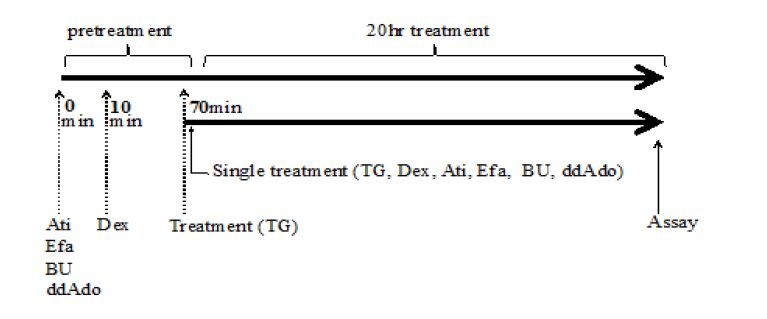
 DownLoad:
DownLoad: 